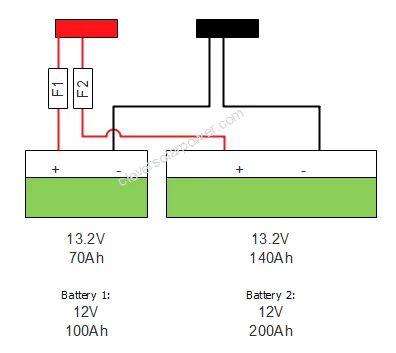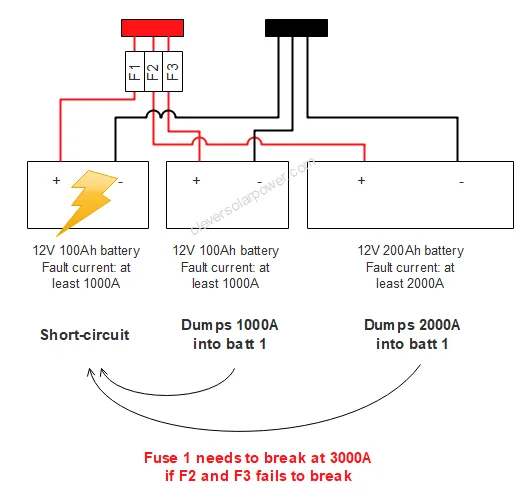Yes, you can mix different capacity lithium batteries, whether a normal 12V 100Ah battery or a Lithium server rack battery.
There are a few points you need to consider when wiring in parallel.
- The batteries must have the same voltage
- The batteries must each have their own BMS
- There should be a fuse installed for every battery
- Have them at the same state of charge before connecting them
Let’s explore these three points. At the end of the article, you will find a diagram on how to wire these.
First some basic knowledge:
Connecting batteries in parallel increases the total capacity Ah of the battery, while connecting batteries in series adds up the battery’s voltage.
1. Batteries must have the same voltage
The total battery bank must be at the same voltage. You must create a separate system for different voltages if you have different voltage batteries.
Your total battery bank, which can have multiple different capacities (Ah), all need to be the same voltage, whether 12V, 24V, or 48V. You need to choose one of these three voltages.
The batteries must have the same chemistry as well. It is not possible to combine lithium-ion with LiFePO4. This is because lithium-ion has a slightly higher voltage than LiFePO4.
The batteries get charged all at the same time. A smaller battery will be at the same voltage as a larger battery. Therefore, the state of charge will be equal in all batteries. Let me explain with a diagram where all the batteries are charged to 70%.

2. Batteries must have their own BMS
The BMS is responsible for managing the charge and discharge process, keeping each cell within safe operating limits, preventing overcharging and over-discharging, balancing the cells, and providing essential data about the battery. Therefore, having a dedicated BMS for each battery can help to ensure that each one operates safely and efficiently, even when the batteries have different capacities.
Some batteries will have different internal resistance. Therefore one battery may be charged quicker than another. Once a battery is fully charged, the BMS will cut off the power to that particular battery to protect it from being overcharged.
3. Batteries must have their own fuse
A fuse for each battery can prevent excessive current from damaging the battery or creating a safety hazard.
The overcurrent protection for the BMS is not enough. You need a physical fuse that can blow to create a separation from the other batteries.
You can use a MIDI fuse if you have a 12- or 24V battery bank at 100Ah. If you have a 48V battery or a total capacity higher than 100Ah, you should use a Class-T or NH00 fuse.
This is because the fault current will exceed ten times the capacity. This means that a 100Ah battery can have a short circuit of 1000A. A MIDI fuse can only break 2000-3000A in a 12V circuit. Therefore if you increase the voltage and the battery’s capacity, a Class-T or NH00 fuse is recommended.
If one battery short circuits, all the other batteries will dump as much current as possible into the shorted one.
As you can see in the example, if Fuse 2 or 3 fails, then Fuse 1 will have to break over 3000A. Therefore I recommend having at least a class-T fuse or NH00 when your total battery capacity is over 100Ah. Read more about fusing here.

4. Have the same state of charge before connecting them
When you connect your batteries in parallel, they must have the same state of charge before connecting them. Because the voltage level of a LiFePO4 battery is flat in the middle, I recommend fully charging or discharging them before connecting.
If you do not connect the batteries when they have the same state of charge (voltage level), then the inrush current can blow your fuses and damage the BMS of the other batteries.
Schematic for multiple lithium batteries in parallel
Here is a diagram for multiple lithium batteries in parallel. You can add individual battery switches after the fuses. From the main busbar, it can go to your inverter, charge controller, or generator.
The negative cables can go to a busbar, then a shunt, then another busbar. If you have 3 batteries or less, you can connect them to the shunt without needing an additional busbar. This is because you can only have a maximum of three lugs on one terminal.

Conclusion
There you have it, connecting multiple lithium batteries with a different capacity. I hope you found this article with the schematics helpful. If you have questions, please leave a comment.
Checkout my video about different capacity batteries and their individual current draw:

I’m an off-grid enthusiast. I created this website to give clear and straight-to-the-point advice about solar power. I’m also the author of the book ‘Off-grid solar power simplified‘. Read more about me on my about page, check out my Youtube channel, or send me a message.
That was a great article, one that I was hoping to fine & read.
Just one question on the fuse.
I want to connect a lithium 220ah 48v & a 120ah 48v lithium battery.
Both batteries have built in breakers along with the built in BMS & active balancer.
Will the built in breakers work to protect the batteries or would I also need to add the fuse’s.
Thanks for your great work here.
The problem with lifepo4 batteries is that they have a high Icc current. This is the current that flows when there is a short circuit. The breaker needs to be able to cut the power to the battery if a short circuit is happening. If the breaker is rated appropriately (which i doubt) then you don’t need one. But I still recommend adding a Class-T fuse of NH00 fuse for every parallel string of batteries (this is what i would do). Read more about Icc current and its importance here
Hi,
I own your book. It’s excellent! But within it I can ‘t find an example of what I’m trying to wire together.
I’d like to add more ah, and use larger batteries than just the 2 Chins LiFePO4 100ah batteries I presently have. My goal here is to not see my cost of these 2 100ah batteries go to waste when moving to a 24v 3000w inverter; and also wanting the increased AH capacity.
1. Id like to connect my present 2 100ah LiFePO4 batteries for 200ah.
2. I’d then like to purchase 2 200ah LiFePO4 batteries for an additional 400ah.
3. I want to add these together to get to 24v and 600ah.
What is the best configuration, with these 4 batteries, so I end up with a 24volt battery bank with a combined AH capacity of 600ah?
Is this going to be possible without it getting to complicated or presenting any real dangers/problems?
– If your existing battery is 12V 100Ah, you cannot make 200Ah if you connect in series. It will become 24V 100Ah. Bring these two batteries in series to a busbar.
– Wire the two additional 200Ah batteries in series to get 24V 200Ah. Bring these lead to the same busbar.
– Then you get one 24V 300Ah battery. Fuse every battery set.
Awesome site and resources. I have been looking around and it’s hard to get a straight answer so THANK YOU. I do a (maybe dumb) question. I have a 12.8v 100ah LifePO04 Weize with charge voltage of 14.4V (14.6V MAX) and a 12.8v 280ah LifePO04 SOK with charge voltage of 14.6v. Are there any considerations for charge voltage slight differences? Or, can I connect it as you have shown above?
Since they are both prismatic cells, you can set the voltage at 14.6V. After the charge is finished, they will settle to 13.6V.
Hi, Great article.
What size fuse should I use to protect an additional 100AH Lithium battery being added in parallel to an existing fused 200AH lithium battery?
Remember that a fuse protects the wire, so since the capacities are not the same i would use the same wire thickness and use the same fuse that you already used for the 200Ah battery.
Nick, I Have a 48V 5KW hybrid inverter. I recently upgraded the batteries (all 12v), from 4x100AH lifepo4 to 4x280AH lifepo4. So I’ve got 4 x 100ah just sitting off to the side, I was kind of hoping I could parallel 1 each on the 280ah +100ah, then put those in series and end up close to 380ah and 48v. Would that do me any good, or are the 100’s just going to drag me back down in reality? I see conflicting info out there. What are your thoughts?
If that doesn’t work, I’ll probably just put together some type of switch to cut over to a second, separate, 100ah bank of batteries when needed. (winter probably)
Do you know of anyone who makes switches to do this – other than the super expensive power transfer switches?
thanks for all the great info!
Doug
You can have the two batteries 48V 100Ah, and 48V 280Ah in parallel with each other. Bring the main cables to a busbar and fuse every battery set. Checkout my video about paralleling batteries here: https://youtu.be/tifuWS4WW5c
Hi what about all the different metal combinations of “lithium” batteries?
https://pushevs.com/2020/04/04/comparison-of-different-ev-batteries-in-2020/
I only work with lifepo4, so i don’t have experience with combining different chemistries. I would say don’t combine them but keep them in separate battery banks.
Thanks, that’s what I am thinking too. Each chemistry having its own BMS. They are rated at the same voltages. So I can see having each chemistry on its own BMS being the safest.
Hi
Can the cable length of each battery to bus bar be of a slightly different length. I know the neg and pos from each battery should be the same but curious due to slightly different battery locations if each string can have its own length. Also when adding to the bus bar is there a prefered position on the busbars for batteries and inverter plus loads. Cheers
The resistance of the battery will increase a bit if the wires are longer. But it’s not going to be a problem. It’s the same as having two different capacity batteries in parallel. Checkout my video about it here. If your busbars have 3 connection points wire it like this: post 1: battery one. Post 2: inverter, post 3: battery two.
I heard that when you have many batteries hooked together that it is best to hook the positive wire to the first battery and the negative to the last battery so they will charge and discharge at the same rate otherwise the first battery will change and discharge faster and will need to be replaced first. Is this right?
Please check the video at the bottom of the article.